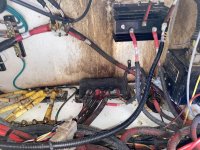bruceb58
Supreme Mariner
- Joined
- Mar 5, 2006
- Messages
- 30,753
You just set the float voltage to 13.5V. Will not harm them at all. Most LiFePO4 battery manufacturers spec that voltage.Do not float charge LIFEPO4 cells / batteries.















You just set the float voltage to 13.5V. Will not harm them at all. Most LiFePO4 battery manufacturers spec that voltage.Do not float charge LIFEPO4 cells / batteries.
Yes, the solar charging essentially does the float charging, based on its capacity. It does not have enough wattage to do the other stages of charging.You just set the float voltage to 13.5V. Will not harm them at all. Most LiFePO4 battery manufacturers spec that voltage.

The solar controller only goes into float once it has completed bulk and absorption. Once it senses a slight reduction in voltage from the battery, it comes out of float and back into bulk, starting the process over again. Not sure how that really works right going through that ArgoFET isolator. I would likely have designed it without that component.Yes, the solar charging essentially does the float charging, based on its capacity.
On lithium batteries, the amount of charge they will accept is as much as the charger can source up until it's close to 100% full. I see 90A received on my older 200AH bank until they were up into the 14V region which is basically fully charged...then it has a slight taper. Now that I have 560AH, they behave exactly the same. Lithium bateries have VERY low input resistance compared to a lead acid battery. On a lead acid battery, since resistance is higher, is what they taper compared to lithium.Question
A Bat charger reduces the amount of Amps as the need for charge is decreased. The solar charger outputs X amount and is dependent on the sun. What regulates the excess power not needed, and where does it go?
Charging of the LFP batteries does not go through the AgroFET. The LFP batteries are connected directly to the Orion. The ArgoFET is on the lead-acid side.The solar controller only goes into float once it has completed bulk and absorption. Once it senses a slight reduction in voltage from the battery, it comes out of float and back into bulk, starting the process over again. Not sure how that really works right going through that ArgoFET isolator. I would likely have designed it without that component.


I never stated what type of batteries get charged from the solar controller through the ArgoFET. Your engine batteries do!!!Charging of the LFP batteries does not go through the AgroFET. The LFP batteries are connected directly to the Orion. The ArgoFET is on the lead-acid side.

26˚ F at my house this AM. Cape Cod was about the same.Ted, it was 41 at my house this morning in Florida.
Only charge back up to the recommended storage voltage unless your gonna be using it within the next 24 hrs. Storing at full charge is not healthy for them either.If your batteries got down to a point where the low voltage discharge kicked in, you need to charge them up...PRONTO! Even if the low discharge of the BMS disconnects, the cells will still self discharge at a rate of 1% to 3% per month and the cells will be ruined eventually.